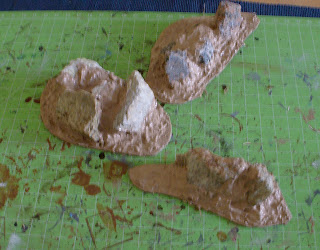As my vision of Middle Earth is a lot more Dark Ages than that of Peter Jackson (I'm looking at the illustrations in The One Ring...), there's too much stone in the movies. Encampments and fortifications should look like an early medieval
Motte than those castles that have fallen into ruin.
So, there have to be wooden palisades instead - and I've started to build one, beginning with the entrance.
The materials: Wooden craft sticks, some wooden chopsticks, twine, cardboard and coffee stirrers.
First, we begin with building sections of palisades by binding eight craft sticks together with twine. Two sections will then be attached to higher beams, made from chopsticks.
Don't throw away the end pieces of the chopsticks yet - we'll make the frame for the gate from them.
Next, we'll do the base. As the wooden stakes would be dug into the ground, we'll use some structure paste to form the earthworks. Form a narrow slit and fill it with PVA glue.
Paint the palisades a dark brown, drybrushing with beige, so the twine looks like rope.
Now, we erect the palisade, putting the walls into the earthworks. Supports are cut from craft sticks and glued to the main beams.
As it will be harder to reach some parts of the base afterwards, we already paint and flock the base.
From cardboard, cut two 2,5 cm wide ledges and cut craft sticks to size that will support the parapet. Glue them to the cardboard and glue the parapets onto the walls and base.
While the glue sets, we'll build the gatehouse. This was used for storing spare arrows and tar in case of an attack, so it is rather small and placed right atop of the gates.
The basic house is made from cardboard and glued together.
While the glue dries, we build the gates. Cut some coffee stirrers to size and glue them to two other stirrers, so you built two leaves. Paint them a dark brown and drybrush them with beige.
Now let's get back to the gatehouse. The cardboard house is covered in wood, coffee stirrers again. Cut them and glue them to the cardboard base. Paint it a dark brown, drybrushing it with beige.
The parapet is also covered with wood and painted. While glue and paint dry, we'll build two ladders for the fighters to get up on the parapets.
Take two craft sticks and a coffee stirrer. Now, cut the stirrer to the desired length of the steps and cut four steps from one piece of stirrer. Form the ladder by glueing the steps to the sticks.
After painting the ladders, they are glued to the parapet and the base.
No, glue the gates into the frame, securing them on the base.
Now, we'll use beige and light grey to weather the wood. paint the tips of the beams in a light colour to simulate the hewn parts, Drybrush light grey along the edges of the wood, where sun and rain work at the wood.
This is just the first piece of palisades, but it the central one. And it is fully usable in play, as soldiers can man the parapets and shoot from them.
And, it looks really good on the gaming table...


































